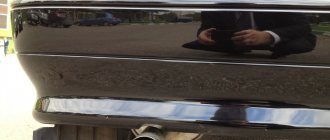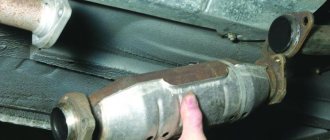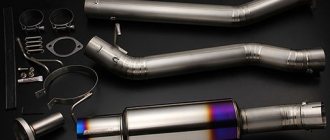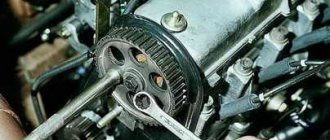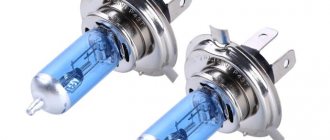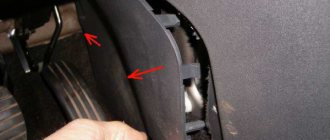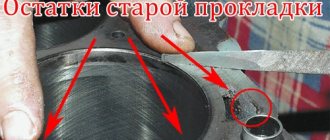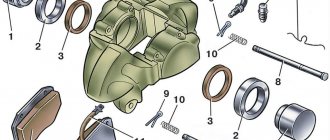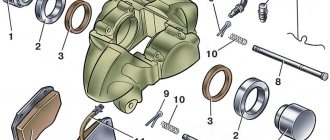Design features
The vehicle's exhaust gas removal system allows not only to remove fuel combustion products, but also to increase the efficiency of the power unit, as well as significantly reduce background noise.
To do this, the system uses a component such as a muffler, which is capable of suppressing the noise created by exhaust gases and significantly reducing their toxicity level. All these indicators depend on how the muffler is designed. Regardless of whether the muffler is manufactured in a factory or assembled by hand, its design must contain the following mandatory elements:
- The exhaust manifold articulates directly with the car's engine through a exhaust pipe, which can be equipped with a vibration compensator.
- Exhaust gases from the exhaust pipe enter the cavity of the catalyst, in which the remaining fuel burns out, and the saturation of carbon dioxide decreases.
- From the catalyst, gas flows flow into the resonator chamber, where vibrations are damped and the effect of their pulsation is balanced.
- Then the volume of exhaust gas flows passes through the chambers of the rear muffler, which is designed to reduce noise.
Principle of operation
Before you begin repairing a car muffler or assembling it yourself, you need to understand the basic principles of its operation. If you look at the device in section, you can see many metal or ceramic partitions, heat-resistant wool, and the presence of perforated pipes. The presence of these elements in the muffler design slows down the speed of gas flows. When doing DIY repairs, it is important to replace worn-out elements with high-quality analogues.
In turn, their reduction allows you to smooth out the operation of the motor, taking into account each stroke.
There are no standards for the production of the exhaust system and its individual elements, so mufflers from different car manufacturers can differ significantly from each other.
If you decide to upgrade individual elements of the exhaust gas removal system with your own hands, then you need to take into account some nuances:
- powerful car engines must have a resonator of sufficiently large volume, which will provide the necessary level of exhaust smoothing;
- the number of partitions inside the chambers that smooth out the unevenness of the volume of discharged flows.
How to replace?
Based on the above, we can conclude that the best muffler repair is to replace it. This statement is also relevant for other parts of the VAZ-2109 exhaust system. The muffler is replaced with an inspection hole, a 13mm spanner and a socket of the same size. All actions are performed step by step:
- The car is driven into the inspection hole and put into gear.
- The main muffler is disconnected from the resonator. To do this you need to find a clamp. Use a spanner to tighten the fastening nut (to prevent twisting). At this time, the bolt is unscrewed with a ratchet.
- Afterwards, the fasteners are removed and the elements of the exhaust system are disconnected. The clamp is reusable, so we will put it back.
- Carefully remove the front part of the muffler from the rubber “cushion”, through which the part is attached to the body. Then the same operation is done with the front “pillows”.
- If the muffler is stuck to the resonator pipe, it can be rotated counterclockwise and back. This makes it easier to remove the muffler.
- The new element is installed in the reverse order.
Types of noise-absorbing elements
Silencers in cars can be active, which is a fairly simple device, or reactive. In the first case, vibration-resistant materials that can withstand high temperatures are used for their production. Active devices are the most popular because they are easy to use. Their significant disadvantage is their rapid contamination. Silencer reactive devices consist of complex elements of resonator chambers.
As for the rear noise-absorbing chamber of the car, its structure contains many compartments that contain a special filler. It is necessary to reduce the sound of exhaust gases when the car engine is running. Modern car mufflers can use several technologies for absorbing background noise and purifying emitted gases at the same time. They can contain many different materials that provide maximum reduction in the sound of exhaust gas flows, their toxicity level and temperature.
Do-it-yourself muffler repair
The main problem with the elements of exhaust exhaust systems is the appearance of holes due to temperature changes and external impact on the body of the elements. If a hole is found in the resonator housing, pipes or rear muffler, you need to make patches from sheet metal. It is necessary to make a margin of about 10-12 mm from the size of the “fistula”, after which the puncture site must be carefully treated.
Do-it-yourself repairs are not particularly difficult. When applying patches, it is advisable to use semi-automatic welding. In this case, it is necessary to ensure the evenness and continuity of the weld. In the same way, defects in pipes and internal elements are restored.
A car muffler is a device that is designed to reduce the noise level, temperature and toxicity of combustion products. Today we will discuss the exhaust system of a VAZ car, and in this article we will provide answers to such common questions as:
- Design of VAZ car mufflers;
- Design features of a direct-flow muffler;
- How to replace the main and additional muffler of a VAZ.
VAZ 2114/2115
There are no innovations in the VAZ 2114/2115 mufflers, the same 4 chambers and three partitions, three perforated pipes and one outlet pipe with an increased diameter.
As a rule, the metal of the outlet pipe rots, and that’s where the rattling noise comes from.
Next, let's look at the muffler design using the UAZ Patriot as an example.
First comes the upper housing casing, under which there is a layer of fiberglass.
Inside there are three chambers, separated by two partitions, two perforated pipes without narrowed sections. There are no vibration-absorbing materials.
The inner diameter of the outlet pipe is 52 mm, the inlet pipe is 53 mm. The outer diameter of the inlet pipe is 57 mm, the outlet pipe is 55 mm. Body length 50 cm.
The UAZ Patriot muffler is no longer distinguished by anything special. It makes a lot of noise and rusts inside.
basic information
The muffler of a VAZ car always receives increased attention, because its main task is to reduce the noise level, which is important. First, let's look at how the pre-muffler, or as it is also called the resonator, of a VAZ car works. A resonator is considered to be a medium type of muffler, which is located in the middle of the exhaust system. So, the pre-muffler consists of the following main elements:
- Throttle;
- Frame;
- Blind barrier;
- Thermal insulation;
- Perforated tube.
Now let's look at the design of this part of the transport:
- Frame;
- Rear barrier;
- Middle obstacle;
- Front perforated tube;
- Rear perforated tube;
- Inlet pipe;
- Exhaust pipe.
VAZ muffler design
What are the design features of a direct-flow muffler? The main element of this type of muffler is a perforated tube. With the help of perforation, the combustion products that enter the muffler expand quite effectively in its body. Thanks to these actions, the removal of combustion products is accelerated. It is worth paying attention to the fact that high-quality tuning can account for more than eighty percent of a straight tube. This means that when using the presented type of muffler, the level of exhaust system resistance will be about ten percent, and this is much more than without it.
Independent replacement of the main and additional muffler
The exhaust system of every vehicle regularly suffers from the accumulation of dirt, dust, moisture, corrosive and hot gases, as well as impacts. Moreover, applying patches to through holes will help solve the problem only for a certain period of time, and in the end, one way or another, a complete replacement will have to be made.
What is important to know about the resonator
Structurally, the pre-muffler is identical to the forward flow described above - a straight perforated pipe passes through the cylindrical body. The only difference is the partition that divides the tank space into 2 chambers.
Resonator tasks:
- dampen primary sound vibrations of large amplitude;
- facilitate the work of the main muffler and extend its life;
- remove some of the heat from the flue gases.
The resonator bank resembles a forward flow, only the part size is smaller
The principle of operation of the element is based on the physical phenomenon of resonance - repeatedly reflecting from the partition and the inner walls of the can, sound waves cancel each other out.
The VAZ 2107 car is equipped with 3 types of resonators:
- The classic option for carburetor engines, used in the first models with an injector, is a long pipe with one or two banks (depending on engine size).
- On injection models that comply with Euro 2 exhaust standards, a shortened resonator section with a flange was installed at the front end of the pipe. The catalytic converter was bolted to it.
The latest VAZ 2107 models were equipped with a neutralizer that took away part of the length of the resonator pipe - After the introduction of Euro 3 standards, the length of the catalyst increased and the length of the resonator decreased. The section for the injection version of the “seven”, which meets these requirements, is equipped with a front flange with 3 bolts.
Euro 2 and Euro 3 resonators differ in the shape of the mounting flange and the length
When operating resonators, the malfunctions described above occur - burnouts, rust and mechanical damage. Troubleshooting methods are similar to repairing a muffler - welding or temporary sealing with a bandage. Removing the resonator section is not difficult - you need to unscrew the fastening to the gearbox, then disconnect the muffler and “pants” pipes. On a VAZ 2107 with an injector, the flange is disconnected instead of the front clamp.
Find out how you can control fuel consumption: https://bumper.guru/klassicheskie-modeli-vaz/toplivnaya-sistema/rashod-topliva-vaz-2107.html
Car muffler tasks
Pipe. Exhaust, but a pipe. It’s a simple device at first glance, but a lot depends on the exhaust system. Not only the aesthetic sound of the exhaust, but also the dynamics of the car, fuel consumption, comfort in the cabin, and the presence of vibrations. Therefore, if someone asks in the middle of the night why a muffler is needed in a car, every self-respecting motorist will answer without hesitation:
- to reduce the noise level of the engine;
- to reduce the temperature of exhaust gases;
- to remove exhaust gases outside the vehicle;
- to reduce the level of harmful emissions into the atmosphere.
Although the last point is rather conditional.
The exhaust pipe works in hellish conditions. The temperature of the exhaust gases at the outlet of the exhaust manifold can reach 800 degrees, or even more. Therefore, the metal from which the muffler is made must not only be durable, but also have some heat-resistant qualities. In addition to temperature, enormous pressure acts on the walls of the exhaust system, and the high speed of movement of exhaust gases causes significant sound vibrations.
Tuning
Those who want to change the exhaust sound to a sportier one can install a straight-through Stinger muffler. The exhaust system of the VAZ-2109 is also modified by installing a “Stinger” brand spider.
As a result, gases will freely leave the combustion chamber. But you need to understand that the exhaust sound will increase several times. Since there are no such labyrinths in a direct-flow muffler, all gases go directly into the atmosphere.
The car will sound sporty, but there is no need to talk about a significant increase in power. A more correct solution is to install such a muffler after upgrading the engine. You can start by installing a 16-valve head, then change the intake system, mount a turbine, and so on. There is no point in installing direct flow on a simple VAZ engine. The standard exhaust system already copes with the exhaust from a simple atmospheric engine. In the case of installing a turbine on a “nine”, such modification is simply necessary.
Sound absorption technologies
The exhaust system, and in particular the muffler, can use one or several sound absorption technologies:
- change in gas flow cross section;
- changing the direction of gas movement;
- surface absorption of sound waves.
Depending on which frequencies predominate in the engine exhaust sound spectrum, this sound reduction method is used. For example, to suppress low frequencies, it is effective to use several resonator chambers with different volumes. The use of different sections of input and output pipes combats high frequencies well. But in principle, a muffler, like a good musical instrument, is customized exclusively for a specific brand of engine. Then the noise reduction efficiency is much higher and there is less power loss.
Malfunctions
Due to its simple design, this system is very reliable and rarely requires attention. But nothing lasts forever, so over the years the muffler and other elements burn out. Most often, it is the muffler that fails, as it takes the entire blow. It can burn out both outside and inside. In the latter case, the breakdown can be determined by the loud exhaust sound. Driving with such a muffler is not dangerous, but not very comfortable. Firstly, sound insulation suffers, and secondly, gases can break into the cabin. Therefore, it is better to replace this element immediately, given that it costs a penny.
Car muffler diagrams
A cross-section of a car muffler allows you to see exactly how the sound reduction function is implemented in each specific muffler. In direct-flow mufflers, for example, the method of changing the direction of gas movement is never used, and a standard muffler uses turns from 90 to 360 degrees. The change in the amplitude of sound wave oscillations is realized by perforating the internal pipes. It is these internal pipes, their diameter, diameter and frequency of holes that can drown out noise in almost the entire frequency spectrum.
But only the integrated use of these methods can guarantee high efficiency of the entire exhaust system as a whole. Therefore, modern cars use from one to six different mufflers. The main ones are the resonator and the main muffler.
What materials are they made from?
Silencers of all types can be made from:
- Of stainless steel;
- Aluminized (alloy of aluminum and steel);
- Regular black steel.
A stainless steel product can last, during active vehicle use, from 6 to 10 years, as it is least susceptible to corrosion.
They are sold on the market in a high price range, their big advantage is that despite the high price, they are mass produced and can be matched to most car brands.
Products made from aluminized steel are sold in the middle price range, they are also quite durable, but they are difficult to match to a specific car brand, since the choice on the market is not large (only a few companies produce them).
It is problematic to make such a muffler in a garage. The main advantage is a long service life of up to 6 years, and are less susceptible to corrosion.
Products made of black steel are mass produced because they are the cheapest. They can be made in a garage for any brand of car, but they will serve for 3, maximum 5 years, then the aggressive environment and rust will do their dirty work.
Main elements of the exhaust system
The muffler resonator is installed immediately after the exhaust pipe and the catalyst, and its task is to level out pulsations of the gas flow. In cross-section, it looks like a perforated pipe placed inside a metal chamber of a larger diameter. The pipe can change its cross-section on the way from the inlet to the outlet of gases.
The main muffler may have a more complex design and has the main function of noise reduction. Modern systems can have almost all noise reduction schemes in the rear muffler can. The chamber through which the main pipe passes can have several sections, each of which has noise reduction at its own level. Typically, these chambers are filled with heat-resistant fiber material, which further dampens vibrations and absorbs sound vibrations.
The design of a car muffler is constantly evolving, and we try to follow the news from the design bureaus of the most progressive automakers and tuning studios. Stay with us, and let your mufflers only please the ears of avid motorists. Happy travels to everyone!
Device
In total, this system includes several elements. This:
- An exhaust manifold. This is the very first part through which gases pass after combustion. People call the collector a spider for its characteristic shape. This element is supplied to each of the four cylinders of the internal combustion engine. Then all these pipes are combined into two, and then into one single pipe. There are also sports manifolds with a 4-2-1 exhaust pattern. They are installed to increase power. As practice shows, gases move more freely along the path, but the driver still will not feel a significant increase in power.
- Reception pipe. It connects to the collector. There is a special probe inside this pipe. This is an oxygen sensor, or lambda probe. If we talk about the VAZ-2109 exhaust system (carburetor), there is no such sensor in the system. But on car injectors, a lambda probe is required. The slightest problems with it may be accompanied by a “Check Engine” lamp on the instrument panel. In fact, the exhaust pipe has the simplest device. There are no sound-reflecting partitions or special fillers. This is an ordinary hollow pipe in which a single sensor can be located.
- Catalyst. As in the previous case, this element is present only on injection versions. There is no catalyst on carburetor engines. What is this element needed for? Its main task is to reduce the concentration of harmful substances in exhaust gases. Passing through the catalyst honeycomb, harmful metals are converted into harmless oxides. Thanks to the use of this element, the machine began to comply with the environmental standard Euro-2 and higher. The catalyst is the most expensive element in the VAZ-2109 exhaust system (injector). Therefore, when it malfunctions, many install flame arresters or simply knock out the core and weld the walls, leaving the catalyst empty inside.
- Resonator. This element is present on both carburetor and injection versions. A resonator is installed behind the catalyst. What is his task? The resonator serves to absorb the main noise from the exhaust gases. Thanks to this element, the sound of gases becomes less. The resonator is designed simply. This is a metal case with a perforated pipe inside. Additionally, there may be a partition inside.
- Main muffler. The resonator can be called an auxiliary muffler, but the main sound energy is absorbed by the last muffler, located under the rear bumper. It enters the resonator and absorbs up to 90 percent of the sound. The structure of this element is somewhat more complicated. The basis here is also taken from perforated tubes, but there are several of them, as well as chambers. Usually these are three or four tubes and two chambers. Passing through this entire labyrinth, the gases lose their energy and exit without unnecessary sound.

